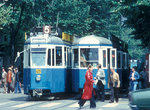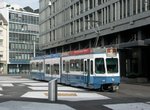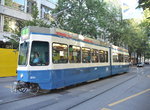Zurich, Switzerland
![]()
Bombardier "Cobra" tram no. 3041 on the Limmatquai near Schweizerhofgasse, on Route 4. Photo by David Pirmann, July 2012.
Overview
Zurich is the largest city in Switzerland and, as one would expect, has a comprehensive public transport system. A considerable network of 'S-Bahn' lines operates, the majority of which are equipped with recently-purchased, fixed-formation heavy rail train sets. A handful of the S-Bahn lines are operated by light-rail vehicles, however. There are also two funicular lines and a rack railway - the Dolderbahn.
An expanding tram network forms the backbone of city's urban transit, and is backed up by both buses and trolleybuses - all operated by Verkehrsbetriebe Zürich (VBZ). The tram fleet, whilst not as varied as nearby Basel's, is in the process of being upgraded and expanded, and is turned out to an exemplary standard - there being no evidence of any minor 'bumps and scrapes', or vandalism. The tram fleet is entirely Swiss built and carries a restrained yet smart blue and white livery.
The newest cars in the fleet are of the Cobra type, which thus far is exclusive to Zurich and is a 100% low-floor model. As seems to be unfortunately common with low-floor tram designs, the initial prototype batch of six suffered from structural problems which necessitated a major rebuild. The production batch of 68 further examples continues to be delivered, and there is an option for a further 35 units.
Most numerous in the VBZ fleet is the Tram 2000 type, first introduced in 1976. This is a two-section articulated car, which still looks surprisingly modern despite the age of the design. An unusual feature is that some Tram 2000 units run in tandem with a second articulated unit; the trailing car, despite being powered, lacks a driving cab. Some also run in tandem with a single, non-articulated trailing car; again, despite being powered, the second car lacks a cab. As is common in other European cities, some of the leading articulated units have been equipped with a low-floor section, which is inserted in the middle to form a three-section car.
Oldest of the active fleet is the Mirage type, three section articulated car. As with the Tram 2000, these also frequently operate in two-unit formations and several have no driving cab, despite being powered. Despite their age - having been first introduced in 1966 - these cars are in excellent condition, although several have been removed from service. Once delivery of the Cobra trams is complete, the Mirage type should be totally removed from service. Of similar appearance to the Mirage is the 'Karpfen', a non-articulated predecessor which operated as a motor and trailer formation. These were removed from service during late 2006, and have been sold to Vinnitsya in Ukraine for further use.
Zurich's trams enjoy mainly segregated track and are thus generally immune to congestion caused by motor vehicles, although some sections around the city centre are conventional street running. One curiosity is a stretch of tram subway, which exists to the north of the city centre. This was initially built to form part of an underground U-Bahn metro for Zurich, but this plan was defeated by referendum in 1973. The section was adapted for use by trams, and is served by routes 7 and 9. Another unusual feature is that all trams except the Cobra cars are adorned with large, colour-coded boards on the sides, indicating the route, its terminals and some of the places passed. Apparently this practice will soon cease on the Tram 2000 cars, although Mirage trams will retain the boards until their withdrawal.
Other light rail activity in the Zurich area abounds, and includes S-Bahn lines S10 and S18, both of which are operated by light-rail type vehicles, to Uetliberg and Esslingen respectivley. The s10 - marketed at Uetlibergbahn - departs from one of two subterranean platforms at the city's main Hauptbahnhof along with the heavy rail Sihltalbahn. As with the tram subway, these two below ground platforms were to have formed part of the stillborn Zurich U-Bahn. The Uetlibergbahn is apparently the steepest standard gauge railway in Europe, peaking at a gradient of 7%, and extends for 10.3km.
The S18 S-Bahn line - the Forchbahn - departs from a street loop adjacent to Stadelhofen station, served by heavy rail S-Bahn trains. It then operates along street track for a short distance. It's operated by tram-esque vehicles, painted in a pleasant red and sand livery. Also in the central area is the Dolderbahn, a metre-gauge rack railway which operates between a lower terminal at Romerhof and Bergstation. It is operated by two small, typically Swiss rack railway cars, although patronage would appear to be poor. It was totally overhauled in 2004, however. Two funiculars also operate - the very short Polybahn, and the longer Seilbahn Rigiblick, which serves three intermediate stops.
To conclude, Zurich is a fascinating destination for tramway or light-rail enthusiasts and has much variety to be seen. VBZ, the local undertaking, has a range of tickets and passes and the latter are valid on all the modes mentioned here, along with main line trains in the relevant zones.
Photo Gallery
| Five Random Images | ||||
 Image 62360 (314k, 1044x727) Photo by: Thierry Leleu |  Image 62363 (291k, 1044x711) Photo by: Thierry Leleu |  Image 77513 (111k, 720x540) Photo by: Tim Deakin Location: Bahnhof Enge |  Image 136026 (401k, 1044x701) Photo by: David Pirmann Location: Central |  Image 136052 (443k, 1044x701) Photo by: David Pirmann Location: Bahnhofstrasse |
Page Credits
By Tim Deakin.